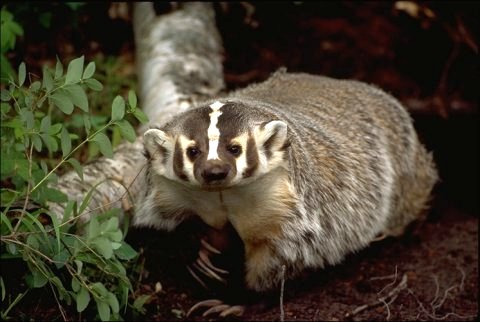


Taxidea taxus. Photographer: Gerald and Buff Corsi; Date of photo: Jun 1995; Location: Kalispell, MT. Copyright © 1999 California Academy of Sciences.
This member of the weasel family possesses the irritability and predatory traits of that group. It has glands that are capable of producing offensive scents; however, they are not as severe as a skunk's defensive mechanisms. The sharp claws and teeth along with loose skin allow it to defend against enemies (Olin 1980). Combining these characteristics with its fierce attitude, the badger seldom worries about being attacked. Its shy, solitary nature, however, makes this animal prefer to avoid any conflicts. The common name ("badger") is probably derived from the white forehead marking which is borne like a badge (Whitaker 1980).
These carnivores have a flattened appearance with a noticeably broad, heavy body and short tail. They have short, thick legs that end in large claws (up to 3.75 cm long) especially adapted for digging; hind claws are shorter (Olin 1980). Badgers possess a shaggy coat colored gray to brown with a conspicuous white stripe that runs from the shoulder to the pointed, mildly upturned snout. Another white patch covers both cheeks, and they have small ears and dark colored feet (Whitaker 1980). Adult males have an average total length of 788 mm and weigh anywhere from 4-10 kg. Females average 730 mm in length and have similar weights (Davis and Schmidly 1994).
The badger occurs in all life zones but appears more commonly in the Lower Sonoran Zone's desert valleys. It is found in almost any type of terrain but prefers deep alluvial soil for digging extensive burrows and shallow holes (Olin 1980). A typical burrow has a roughly elliptical entrance about 20-30 cm in diameter to accommodate the badger's flattened body. A large mound of earth surrounds the hole, and it is often scattered with bones, fur, droppings, and so forth (Whitaker 1980).
Taxidea taxus is found across the western U.S. and east to eastern Texas and Oklahoma and parts of Missouri, Illinois, Indiana, and Ohio. Canada hosts the badger in southeast British Columbia, Alberta, Manitoba, and southern Saskatchewan (Whitaker 1980).
The badger's diet consists primarily of ground squirrels and other small mammals like pocket gophers, kangaroo rats, and many similar burrowing rodents. This powerful hunter will dig out cottontails on occasion, and it will sometimes dine on lizards, birds, eggs, insects, or carrion (Davis and Schmidly 1994).
Usually a solitary creature, the badger becomes more social during mating season. It will breed in summer and early fall, and the male is known to mate with more than one female. There is delayed implantation until December to February, and offspring are born around March or April (Davis and Schmidly 1994). Litters have 2-5 young that are born well furred and blind. They are weaned in June and dispersed in the late summer (Whitaker 1980).
Davis, W. B., and Schmidly, D. J. 1994. The Mammals of Texas. Texas Parks and Wildlife Press, Austin, 338 pp.
Olin, G. 1980. Mammals of the Southwest Deserts. Southwest Parks and Monuments Association, Tucson, 99 pp.
Whitaker, J. O., Jr. 1980. The Audubon Society Field Guide to North American Mammals. Alfred A. Knopf, Inc., New York, 745 pp.
Todd Spurgeon, October 1997.
Last Update: 27 Jul 2009